Introduction
A. Explanation of ISO 27001 Certification
ISO 27001 certification is an internationally recognized standard for information security management systems (ISMS). It provides a systematic approach for managing sensitive company information, ensuring its confidentiality, integrity, and availability. The certification demonstrates that an organization has implemented robust information security practices and is committed to protecting data assets from various threats.
B. Importance of Information Security in Today’s Business Landscape
In today’s interconnected world, where businesses rely heavily on digital technologies and data-driven processes, information security has become paramount. Cyber threats are on the rise, ranging from data breaches and ransomware attacks to insider threats and social engineering scams. These incidents not only result in financial losses but also damage a company’s reputation and erode customer trust. Failure to comply with these regulations can lead to severe penalties and legal consequences.
Given these challenges, ensuring robust information security measures is essential for businesses of all sizes and industries. It is not just a matter of protecting data; it’s about safeguarding the overall integrity and continuity of business operations.
C. Purpose of the Blog
The purpose of this blog is to provide comprehensive guidance on achieving ISO 27001 certification. We aim to demystify the certification process, outline its benefits, and offer practical insights into implementation. Whether you are new to ISO 27001 or seeking to enhance your existing information security practices, this blog will serve as a valuable resource.
Throughout the blog, we will delve into the key aspects of ISO 27001 certification, including understanding the standard, preparing for certification, implementing necessary measures, navigating audits, and maintaining compliance. By following the steps outlined in this blog, businesses can strengthen their information security posture, mitigate risks, and demonstrate their commitment to safeguarding sensitive data.
Understanding ISO 27001
A. Overview of ISO 27001 Standard
ISO 27001 is an internationally recognized standard that specifies the requirements for establishing, implementing, maintaining, and continually improving an information security management system (ISMS). The standard provides a systematic approach to managing sensitive information and mitigating risks related to information security.
At its core, ISO 27001 emphasizes the importance of adopting a risk-based approach to information security. It requires organizations to identify and assess information security risks, implement appropriate controls to mitigate these risks, and regularly monitor and review the effectiveness of these controls.
ISO 27001 is structured around several key clauses, including:
- Scope: Defining the boundaries and applicability of the ISMS within the organization.
- Leadership: Establishing leadership commitment and defining roles and responsibilities for information security.
- Planning: Setting objectives, conducting risk assessments, and developing plans to address identified risks.
- Support: Providing resources, competence, awareness, and communication mechanisms to support the ISMS.
- Operation: Implementing and controlling information security measures and processes.
- Performance Evaluation: Monitoring, measuring, analyzing, and evaluating the performance of the ISMS.
- Improvement: Taking corrective and preventive actions to address non-conformities and continually improve the effectiveness of the ISMS.
B. Key Principles and Requirements
The key principles and requirements of ISO 27001 include:
- Risk Assessment and Treatment: Organizations must systematically identify, analyze, and evaluate information security risks and implement appropriate controls to mitigate or manage these risks.
- Continual Improvement: ISO 27001 emphasizes the importance of continually monitoring, reviewing, and improving the effectiveness of the ISMS to adapt to changing threats and organizational needs.
- Management Commitment: Leadership commitment and involvement are crucial for the successful implementation and maintenance of the ISMS. Top management must demonstrate support for information security initiatives and allocate necessary resources.
C. Benefits of Implementing ISO 27001
Implementing ISO 27001 offers numerous benefits for organizations, including:
- Enhanced Information Security: ISO 27001 provides a systematic framework for identifying, assessing, and managing information security risks, leading to enhanced protection of sensitive information assets.
- Compliance with Regulatory Requirements: ISO 27001 helps organizations demonstrate compliance with various regulatory requirements related to information security, such as GDPR, HIPAA, and PCI DSS.
- Improved Business Continuity: By identifying and mitigating information security risks, ISO 27001 helps organizations enhance their resilience to cyber threats and ensure the continuity of business operations.
Preparing for ISO 27001 Certification
A. Assessing Current Information Security Measures
Before embarking on the journey towards ISO 27001 certification, it is essential for organizations to assess their current information security measures. This assessment involves evaluating existing policies, procedures, controls, and practices related to information security. Key steps in this process include:
- Review of Existing Documentation: Organizations should review their existing information security documentation, including policies, procedures, guidelines, and standards, to understand the current state of information security governance.
- Gap Analysis: Conducting a gap analysis involves comparing current information security practices against the requirements of ISO 27001. This helps identify areas where the organization’s practices may fall short of ISO 27001 requirements and highlights areas for improvement.
- Assessment of Information Security Controls: Organizations should assess the effectiveness of existing information security controls and mechanisms in place, such as access controls, encryption, incident response procedures, and employee awareness training.
B. Gap Analysis and Risk Assessment
Following the assessment of current information security measures, organizations should conduct a comprehensive gap analysis and risk assessment to lay the foundation for ISO 27001 certification:
- Gap Analysis: The gap analysis involves comparing the organization’s current information security practices against the requirements specified in ISO 27001. This helps identify gaps and discrepancies that need to be addressed to achieve compliance with the standard.
- Risk Assessment: Risk assessment is a critical component of ISO 27001 certification preparation. Organizations should identify and assess information security risks that could potentially impact the confidentiality, integrity, or availability of sensitive information assets. This involves evaluating the likelihood and potential impact of various threats and vulnerabilities.
- Documentation of Findings: It is essential to document the findings of the gap analysis and risk assessment process, including identified gaps, risks, and proposed risk treatment measures. This documentation serves as a basis for developing information security policies and procedures and guiding the implementation of the ISMS.
C. Developing Information Security Policies and Procedures
Developing robust information security policies and procedures is a fundamental requirement for ISO 27001 certification. This involves:
- Procedure Development: Procedures should be established to support the implementation of information security policies and controls. These procedures should outline step-by-step instructions for implementing security measures, responding to incidents, conducting risk assessments, and managing access to sensitive information.
- Employee Awareness and Training: Employees play a crucial role in maintaining information security. Organizations should develop training programs and awareness initiatives to educate employees about their roles and responsibilities in safeguarding sensitive information and complying with information security policies and procedures.
Conclusion
A. Recap of Key Points
In this blog, we have explored the process of preparing for ISO 27001 certification, starting from understanding the standard to developing information security policies and procedures. Key points covered include:
The significance of ISO 27001 certification as an internationally recognized standard for information security management systems.
The necessity of developing comprehensive information security policies and procedures aligned with ISO 27001 requirements.
The benefits of implementing ISO 27001, including enhanced information security, regulatory compliance, improved business continuity, and increased customer confidence.
B. Final Thoughts on the Significance of ISO 27001 Certification
ISO 27001 certification is not just a badge of honor; it is a testament to an organization’s commitment to information security excellence. In today’s rapidly evolving threat landscape, where data breaches and cyber-attacks are prevalent, ISO 27001 provides a structured framework for organizations to mitigate risks, protect sensitive information assets, and maintain the trust and confidence of stakeholders.
C. Encouragement for Businesses to Pursue Certification
It is a proactive step towards strengthening information security governance, mitigating risks, and ensuring compliance with legal and regulatory obligations. We encourage businesses of all sizes and industries to embark on the journey towards ISO 27001 certification. While the process may require dedication, resources, and effort, the benefits far outweigh the challenges.


